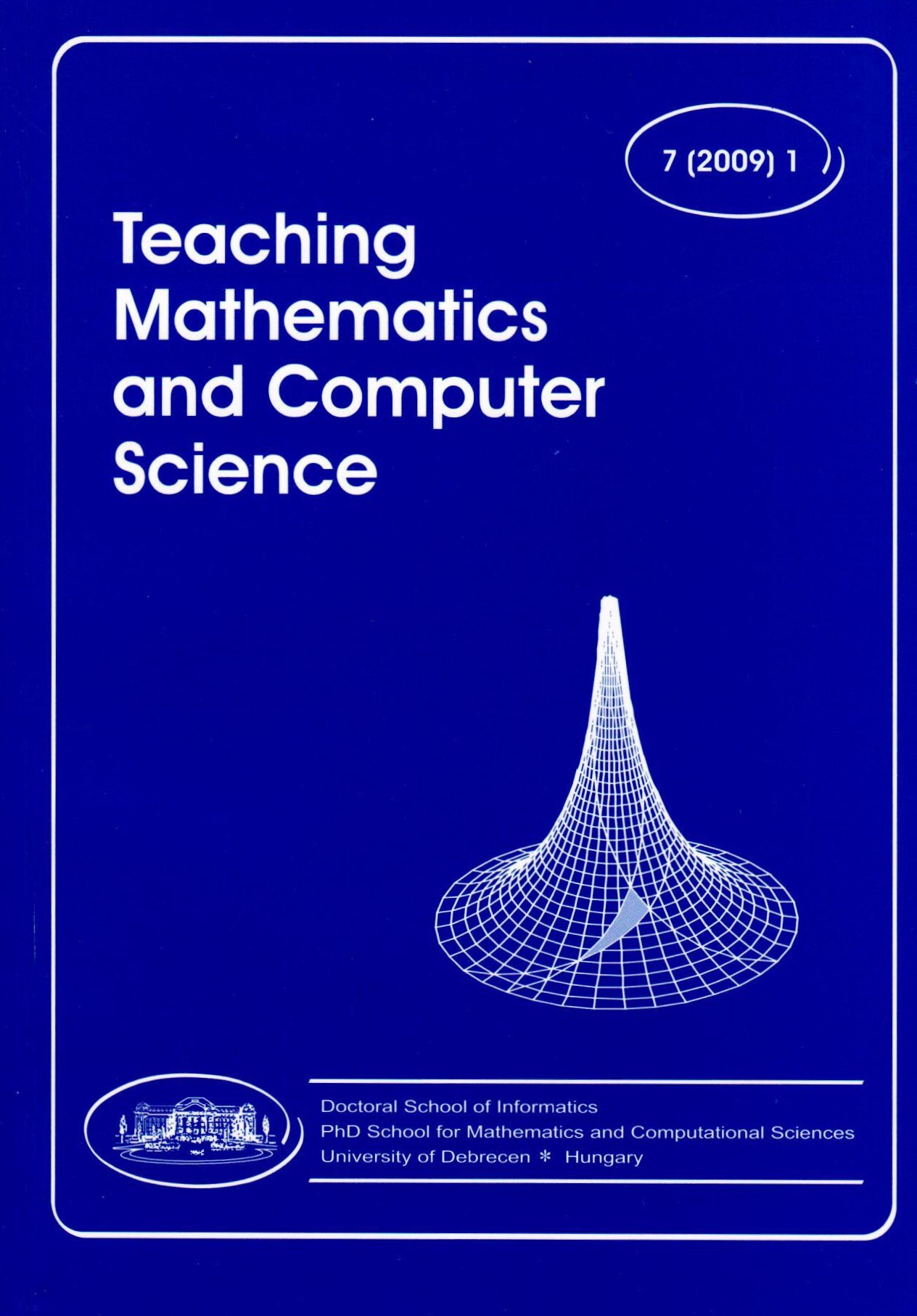Vol. 7 No. 1 (2009)
Published
2009 June 1
##issue.tableOfContents##
Articles
-
Reflecting upon reflections
1-12Views:78This paper considers many applications of reflections in geometry. It begins with a few motivational problems for the classroom and goes on to consider the formal application to cases involving reflections across one line, two lines and three lines. It wraps up with a summary of results for reflections in higher orders.
All this stuff was treated in German and American schools too – so the paper is a typical example of German-American didactics.
"Thinking is one of the greatest pleasure of mankind." – Galileo GalileiPDF50 -
An e-learning environment for elementary analysis: combining computer algebra, graphics and automated reasoning
13-34Views:370CreaComp is a project at the University of Linz, which aims at producing computer-supported interactive learning units for several mathematical topics at introductory university level. The units are available as Mathematica notebooks. For student experimentation we provide computational, graphical and reasoning tools as well. This paper focuses on the elementary analysis units.
The computational and graphical tools of the CreaComp learning environment facilitate the exploration of new mathematical objects and their properties (e.g., boundedness, continuity, limits of real valued functions). Using the provided tools students should be able to collect empirical data systematically and come up with conjectures. A CreaComp component allows the formulation of precise conjectures and the investigatation of their validity. The Theorema system, which has been integrated into the CreaComp learning environment, provides full predicate logic with a user-friendly twodimensional syntax and a couple of automated reasoners that produce proofs in an easy-to-read and natural presentation. We demonstrate the learning situations and the provided tools through several examples.PDF53 -
Teaching graph algorithms with Visage
35-50Views:149Combinatorial optimization is a substantial pool for teaching authentic mathematics. Studying topics in combinatorial optimization practice different mathematical skills, and because of this have been integrated into the new Berlin curriculum for secondary schools. In addition, teachers are encouraged to use adequate teaching software. The presented software package "Visage" is a visualization tool for graph algorithms. Using the intuitive user interface of an interactive geometry system (Cinderella), graphs and networks can be drawn very easily and different textbook algorithms can be visualized on the graphs. An authoring tool for interactive worksheets and the usage of the build-in programming interface offer new ways for teaching graphs and algorithms in a classroom.PDF67 -
Teaching Fourier series, partial differential equations and their applications with help of computer algebra system
51-68Views:118In this paper, some examples of Fourier series and partial difference equations will be shown to demonstrate opportunities for CAS use in various circumstances. The well-known white-box – black-box teaching-learning techniques and the modularization will be used to allow the use of the same worksheet in different ways.PDF52 -
Apollonius' problems in grammar school
69-85Views:127In this work there are ten problems of Apollonius listed with illustrations and solution possibilities including students' solutions, too. Usually, it is rather difficult for students to grasp the essence of these problems with the use of traditional means, bows and rulers, but the use of computers offers higher accuracy.PDF62 -
On a special class of generalized conics with infinitely many focal points
87-99Views:90Let a continuous, piecewise smooth curve in the Euclidean space be given. We are going to investigate the surfaces formed by the vertices of generalized cones with such a curve as the common directrix and the same area. The basic geometric idea in the background is when the curve runs through the sides of a non-void triangle ABC. Then the sum of the areas of some triangles is constant for any point of such a surface. By the help of a growth condition we prove that these are convex compact surfaces in the space provided that the points A, B and C are not collinear. The next step is to introduce the general concept of awnings spanned by a curve. As an important example awnings spanned by a circle will be considered. Estimations for the volume of the convex hull will be also given.PDF82 -
Teaching sorting in ICT
101-117Views:140This article is aimed at considering how an algorithmic problem – more precisely a sorting problem – can be used in an informatics class in primary and secondary education to make students mobilize the largest possible amount of their intellectual skills in the problem solving process. We will be outlining a method which essentially forces students to utilize their mathematical knowledge besides algorithmization in order to provide an efficient solution. What is more, they are expected to use efficiently a tool that has so far not been associated with creative thinking. Sorting is meant to be just an example, through which our thoughts can easily be demonstrated, but – of course the method of education outlined can be linked to several other algorithmic problems, as well.PDF56 -
Teaching word processing - the theory behind
119-137Views:132It is widely thought and believed that word processors – especially MS Word – are software, which everyone can use. However, if we take a closer look at the documents we find that the picture is not at all that clear. In most of these documents even the basic rules of word processing are broken. The question is how it is possible that most of the users are satisfied with their performance, and do not realize that they only use a less noisy typewriter, and not able to take advantage of the opportunities offered by these software. In the search of clearing this misunderstanding I found that there are no publicly available sources, which would clearly set the rules to determine when the documents are properly formatted. Here I set three maxims which, together, are able to control the tools applied in word processing in order to create properly formatted texts. In summary, they state that the layout of a properly formatted text should be invariant to modification, that is, any modification of the body of text should not initiate its re-formatting. To prove that these maxims work and to show that we desperately need them I give examples of works of professionals from the administration, of those who passed ecdl exams, of teachers of various subjects, and finally of teachers of Informatics.PDF49 -
Teaching of problem-solving strategies in mathematics in secondary schools
139-164Views:96In the Hungarian mathematics education there is no explicit teaching of problem-solving strategies. The best students can abstract the strategies from the solutions of concrete problems, but for the average students it is not enough. In our article we report about a developmental research. The topic of the research was the explicit teaching of two basic strategies (forward method, backward method). Based on our experiences we state that it is possible to increase the effectivity of students' problemsolving achievement by teaching the problem-solving strategies explicitly.PDF43 -
Report of meeting Researches in Didactics of Mathematics and Computer Sciences: January 30 - February 1, 2009, Debrecen, Hungary
165-186Views:108The meeting Researches in Didactics of Mathematics and Computer Sciences was held in Debrecen, Hungary from January 30 to February 1, 2009. The 49 Hungarian participants – including 15 PhD students – came from 18 cities and represented 29 institutions of higher education. The abstracts of the talks and the posters and also the list of participants are presented in this report.PDF44
Keywords
Issues by Year
2020
2017
2011
2010
2009
2007
2006
2005
2004
2003







